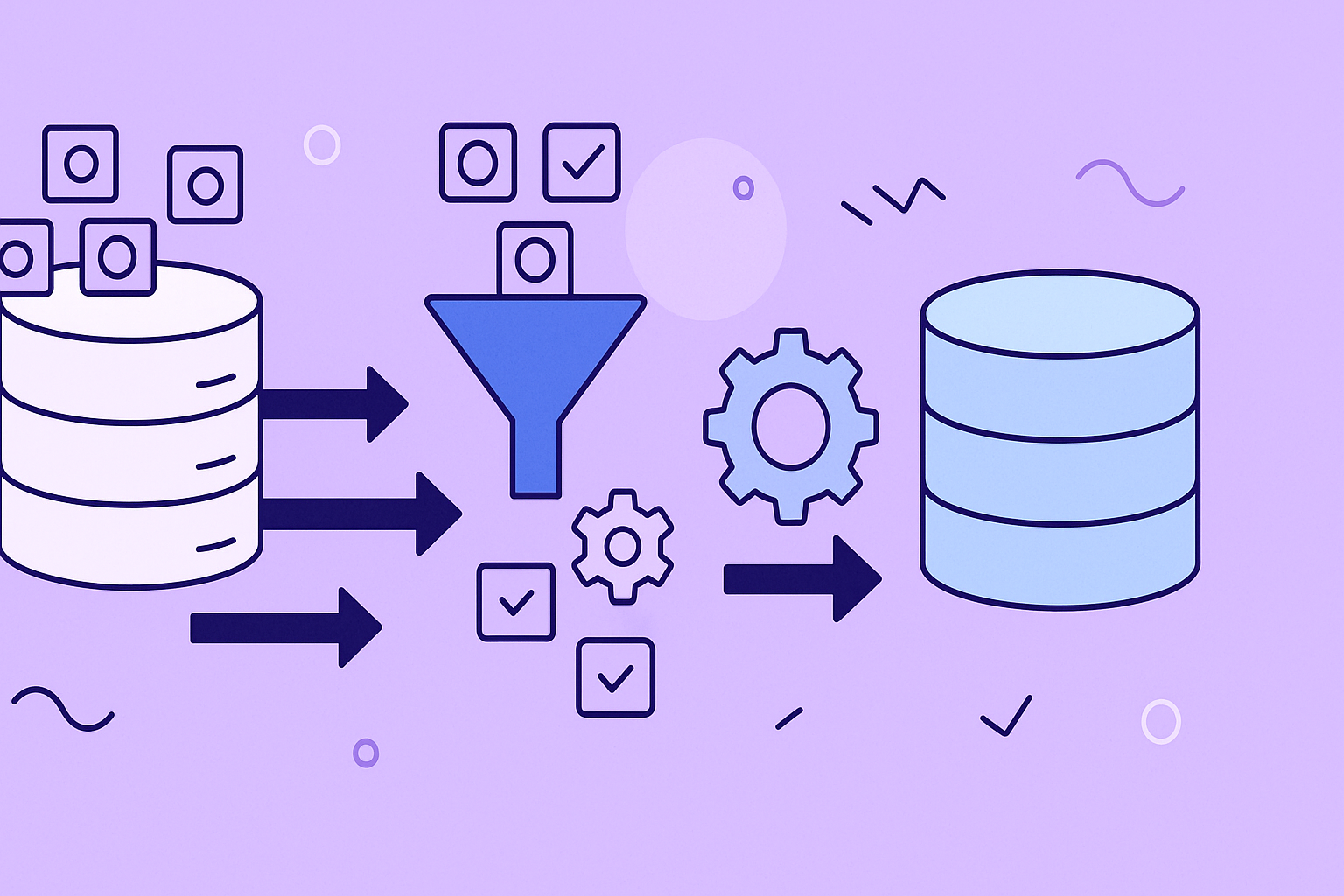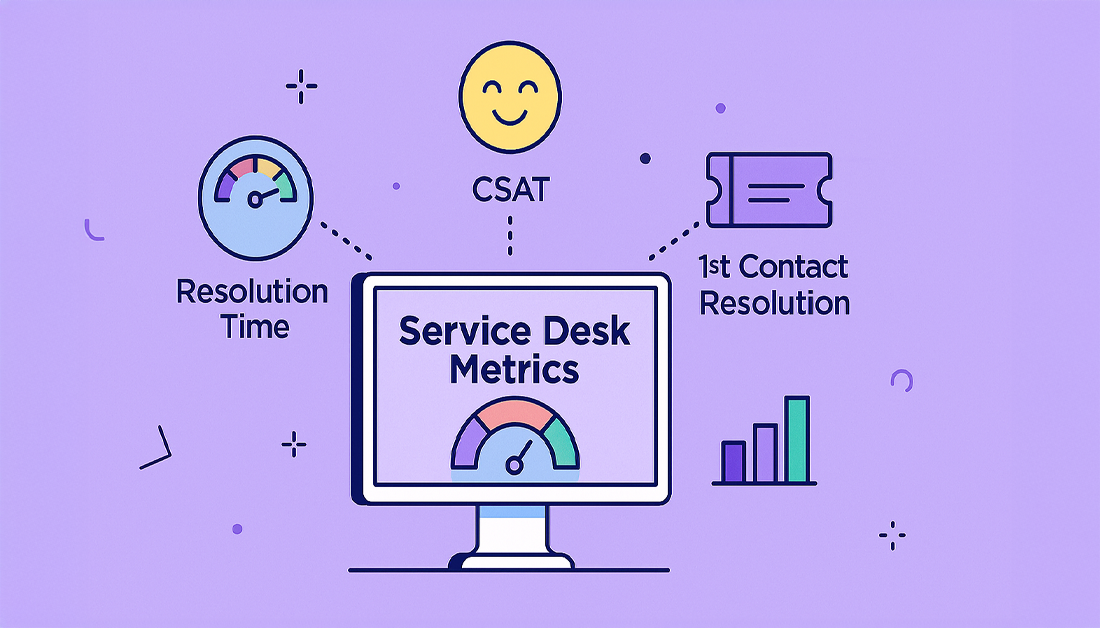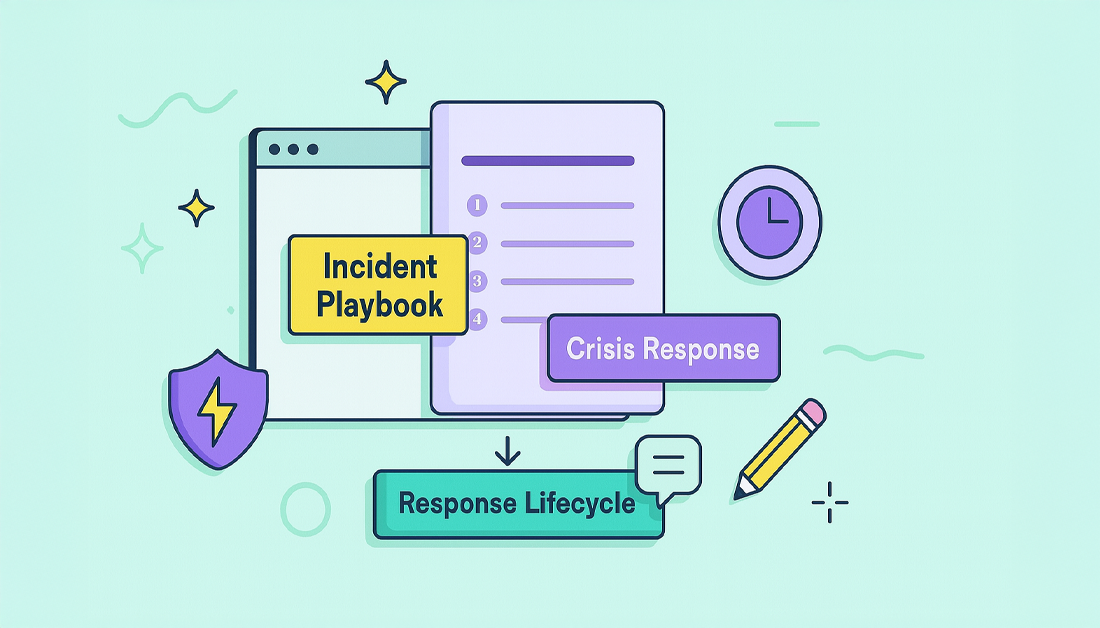Sales teams massage contacts into closing deals, but they need product improvements to finalize the best contracts. A HubSpot Jira integration can go a long way in creating a shared comms channel and diffusing the classic tension and blame game.
Tech vs Sales (or Jira vs HubSpot): the classic SaaS turf wars
In one of my last jobs, I worked as the first product marketer for a young and promising startup. I was very excited at the challenge of defining the function, and envisioned myself talking to customers, pitching to analysts, researching competitors, coming up with new and fresh ways to explain the product.
I was wrong. My job was to enforce a peace treaty.
It took me two months to see the truth. Sales and product were engaged in a cold war. Sales was permanently frustrated that the product wasn’t moving fast, while the tech team was irritated that sales ignored how complex the product was and how much work was needed to ship any changes.
It was common for customers to say they would churn because they were missing some additional functions. It was common to lose these customers. Tech was blamed for not delivering and sales was accused of not knowing how to sell the existing product.
That’s a bad position to be in for a product marketing manager – and a catastrophic one for the company. But it’s not unusual!
Keep reading about HubSpot
The hostile request that doesn’t make it to Jira
Hostilities and prejudices between customer-facing teams and developers have become common place. Salesmen are arrogant, only interested in money and power dynamics, while developers are introvert, obsessed with perfection, and don’t care about making the product appealing to customers.
The classic question from sales to product is a perfect example of how poorly sales teams tend to communicate with developers. Let’s look at the formula:
“Can you create a new ABC function for ACME? They need it by end of month“.
At the receiving end of the chain, smart people end up being told what to do. This can be very demotivating for developers, and can result in lack of ownership, too much focus on short term, higher turnover.
Daniele Beccari, Chief Product Officer at HealthHero
Everything is wrong here. The formula is divisive and aggressive. It lacks context about why ACME is an important customer, and it doesn’t explain what ACME wants to accomplish with the ABC function.
Very frequently, this question is met with a sigh, a shrug, and a laconic: no, I can’t do it. A self-defensive answer, since developers don’t want to be distracted from what they are building, and often feel that explaining their reasons to say no would look as an elaborate excuse anyways.
So… is there a way to build a common language between customer-facing and technology-facing folks?
How to build a common language between Sales and Tech
The point here is that if the requirement isn’t properly investigated, clearly defined, and thought through, then regardless of how well it is coded and tested, the feature won’t get used, and nobody is happy.
Takumi Toki
Companies are often guilty of segregating their teams. Developers and sales teams often work in separate offices, attend different events… and use different tools, even for communication and collaboration. Overtime, this leads, almost inevitably, to echo chambers and a lack of shared vision.
More importantly, features that are shipped out of a quick interaction with business teams without getting the customer involved are often ill defined and less marketable.

Explain why requests are important
Entrepreneur and Product Strategist Zack Bloom recommends rephrasing requests so that this context is always included. Instead of the one liner version, he suggests using a more elaborate request:
Right now we are trying to hit a pretty big sales target set by management. We’re all going a little crazy trying to make it happen, but it’s a challenge. I have this prospect who would bring in enough revenue to make a difference, but they’re asking for a way to export their data. They need it because their compliance requirements say they need an offline backup of all customer data, even what we store. I know it’s not on the product roadmap, and it’s a big ask, but can you think of a way we can solve that problem for them and close the deal before the end of the month?
This example uses an approach in 5 simple steps, which start with explaining the big picture and end up in a collaborative search for a workable solution. Here’s the whole framework:
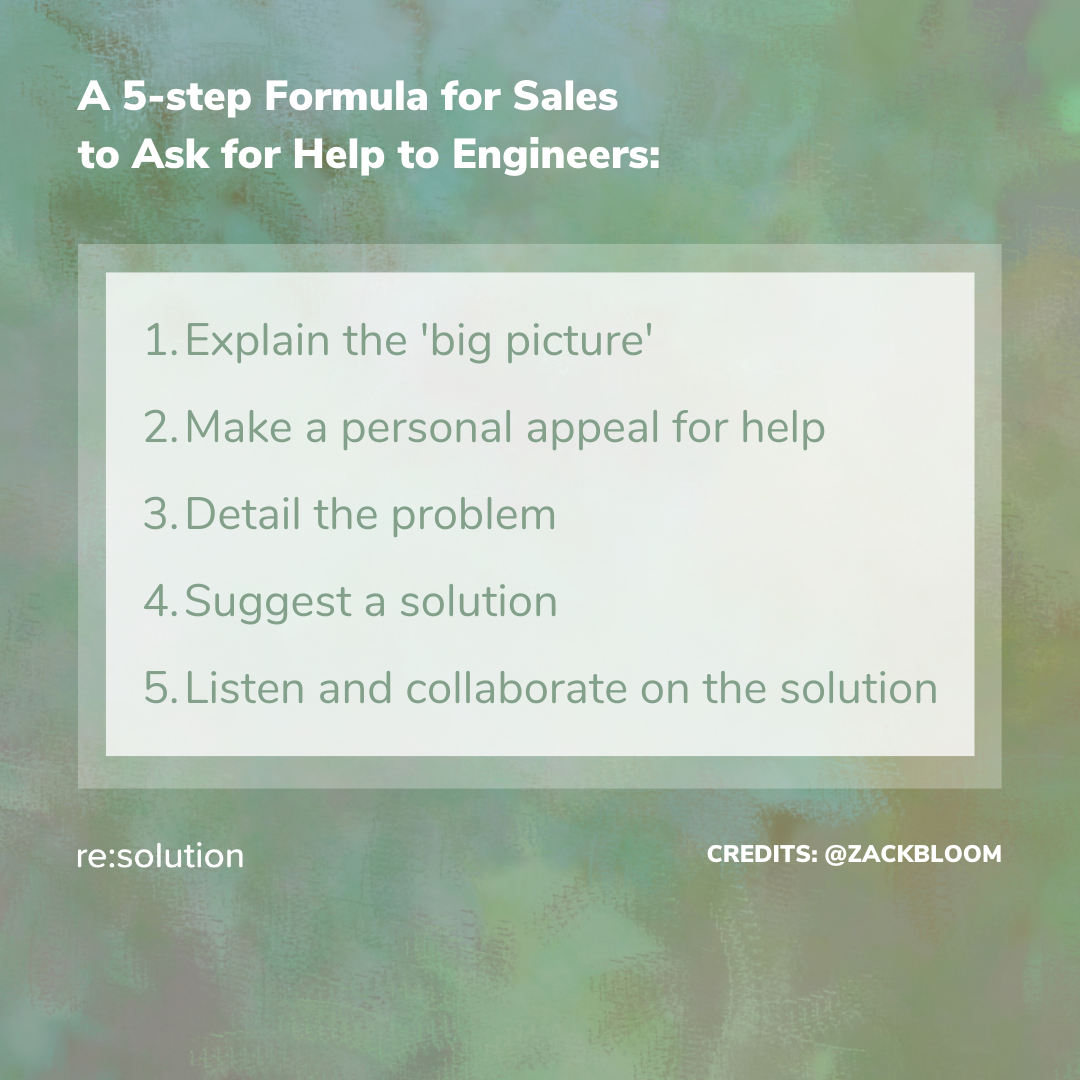
How to communicate across teams using Jira and HubSpot
At my former employer, tech collaborated with Jira, and sales worked their opportunities on HubSpot. HubSpot was never accessed by product managers, and sales folks never accessed Jira. Requests made by sales trickled down from the HubSpot pipeline, but lost all business rationale when they were passed on.
The wrong idea: access for all to HubSpot and Jira
When I’ve discussed the topic, one suggestion that quickly makes its way into the conversation is giving access to each other’s tools. “If the problem is that developers don’t know what account executives deal with in Salesforce, let’s just give them accounts so they can see for themselves”.
This solution can prove to be very expensive. But that’s not the main drawback.
In my experience, the approach is too simplistic. To make it work, users must learn what the software can do for them, and how it can be navigated. Account executives would have to go through a Jira training, and developers would have to be trained in HubSpot. Or even worse, if what you’re using is Salesforce.
I’ve never embarked on a similar training, but I bet it would be surrounded by complaints like “I don’t know why we’re spending time on this” and a reluctant atmosphere. And even afterwards, the pain would still be there: sales people wouldn’t understand most technical descriptions of Jira issues.
If an account executive asks to create a new function for a big deal, a link to that deal in HubSpot will be better than no context at all. But a lot of the important points are still missing.
According to Takumi Toki, for every new function, product experts need to understand:
- Does the function really satisfy the users’ requirements?
- What is the background behind the request for this function?
- Could this function be realized with existing functions?
The right idea: integrating Jira with HubSpot
Following Toki’s suggestion, both sides should find an established channel for discussing requests for new features. A channel that can be monitored, reviewed, and measured. Ideally, however, it should be monitored, reviewed, and monitored from both sides. And this makes it a bit more complex to implement.
A good approach is to embed these conversations in the tools used by both teams: one channel, two platforms. For example, integrating Jira issues into HubSpot so that sales executives can raise the requests and follow up on them without having to log into the platform that engineers use.
Compared to the attempt of expecting proactive access to a second tool, this approach integrates Jira with HubSpot with the aim of having a single flow of communication that feels native to both parties.
It’s an easier sell for everyone. Instead of requesting account executives to learn to navigate Jira, a sales leader can announce that requests to tech should be raised directly from HubSpot – and shares best practices on how to do so. Account executives will then be able to raise a feature request or a support ticket with two clicks. On the other side, tech receives another input that doesn’t disrupt the process in Jira.
The current market of Jira HubSpot integrations.
This is precisely the starting point for resolution’s HubSpot for Jira app. There are already integrations between HubSpot and Jira, but all of them focus on different aspects. HubSpot’s own integration links HubSpot tickets with Jira issues, restricting the workflow to support teams. Appsvio‘s approach is to display static information from HubSpot in Jira and from Jira in HubSpot. Not to mention two-way sync’s like Unito.
The advantages of HubSpot for Jira
resolution’s HubSpot Jira integration is unique in that it allows to link Jira issues to any HubSpot object: contacts, deals, companies, or tickets. This has the potential of making the app an essential piece of each team’s operations: Marketing will likely link leads to user stories; sales mostly links feature requests to deals; and support teams will generally work on tickets. Without being confined to the HubSpot tickets, they can operate from their much more powerful queues in Jira Service Management.
Christiaan Joubert, Product Marketing Manager for HubSpot CRM for Jira
When an issue is created from HubSpot, it is already linked to relevant information: Which deal led to the idea, which customer is behind it, and who’s the internal stakeholder sponsoring the request. This makes it easier for developers to go ahead and click on the link to HubSpot, where they can use additional info to prioritize the effort. For example, they can look at what company is behind the ask or how much revenue is at stake.
With that starting point, it becomes far easier to follow Toki’s advice make specific questions about function that is being requested. Investigating the requirement accurately and coming up with a plan that is successful both technically and commercially is no longer a panacea!
Let’s now see in detail how to build a joint communication channel to align conversations between product and sales, using resolution’s HubSpot CRM for Jira app.
Step 1: Creating a Jira issue from HubSpot
HubSpot deals are the equivalent of an account executive’s home office. It’s the page that they know best, where they make small changes and rearrangements every day.
Here’s how easy it is to raise a new Jira issue from a deal (the same can be done for tickets, contacts, or companies)
But what happens when another customer makes the same ask one month later?
Instead of duplicating the issue, the new customer can be linked to the old Jira ticket as well, adding traction to the request! This will result in a Jira ticket with multiple links to deals, contacts, companies… (see Step 3).
Step 2: Comment on Jira requests from Jira… and HubSpot
Once Jira issues have been created from HubSpot or are linked to a HubSpot object, the common ground for a conversation is there! Check the exchange in the video!
Step 3: Show how many HubSpot deals are affected by a specific feature request.
Prioritizing is much easier when you have tangible proof that a new functionality has only been requested by a customer, when a different release could make a dozen customers happy and decrease churn!
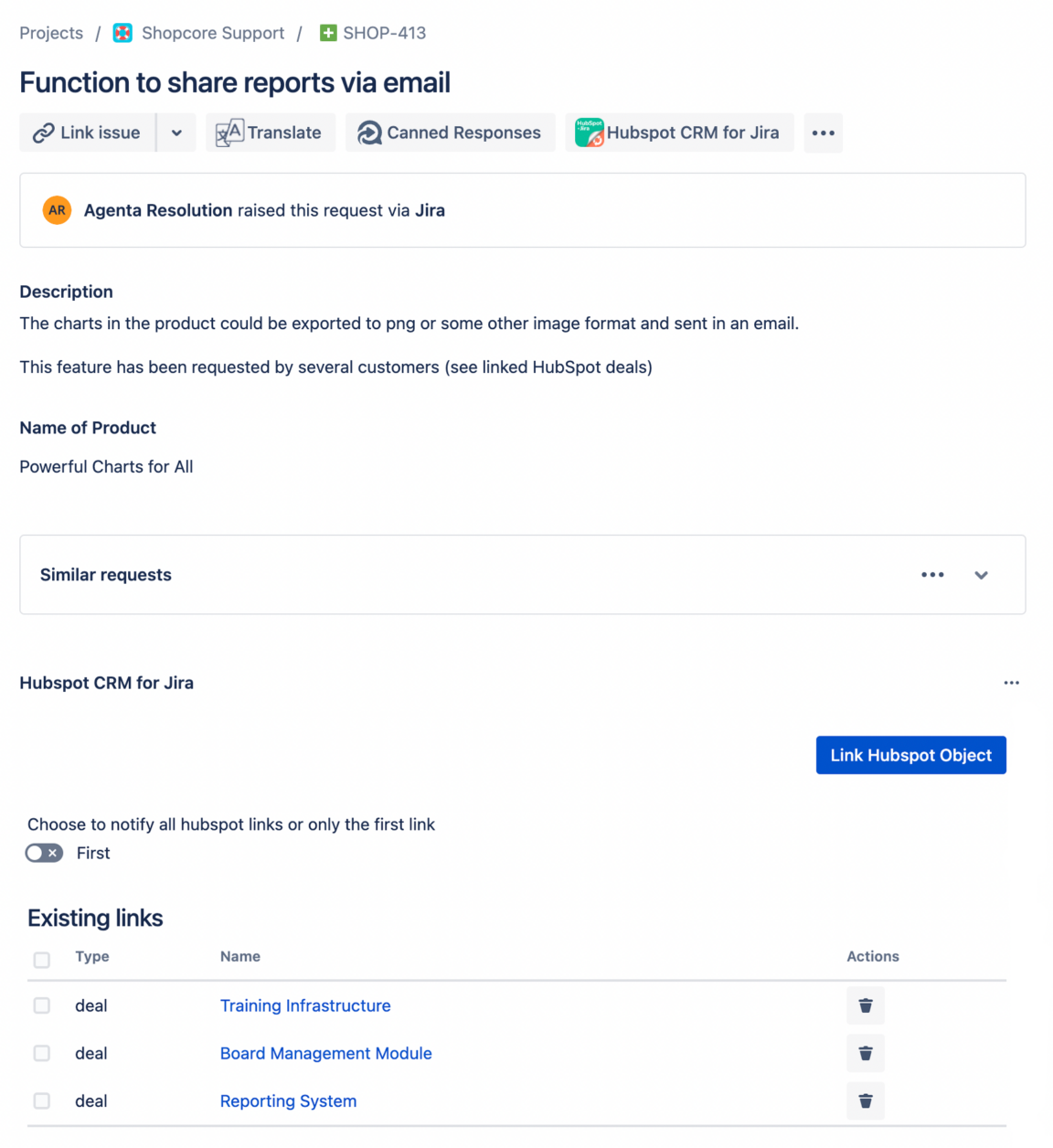
Step 4: Show how many Jira issues are linked to a HubSpot object
Similarly, HubSpot will keep track to every Jira issue linked to each object. This is tactical gold! Sales teams are always looking for a good excuse to check again with a prospect and motivate them to buy. Having updates of bug fixes, support resolutions and new features without asking for them is a huge productivity boost!
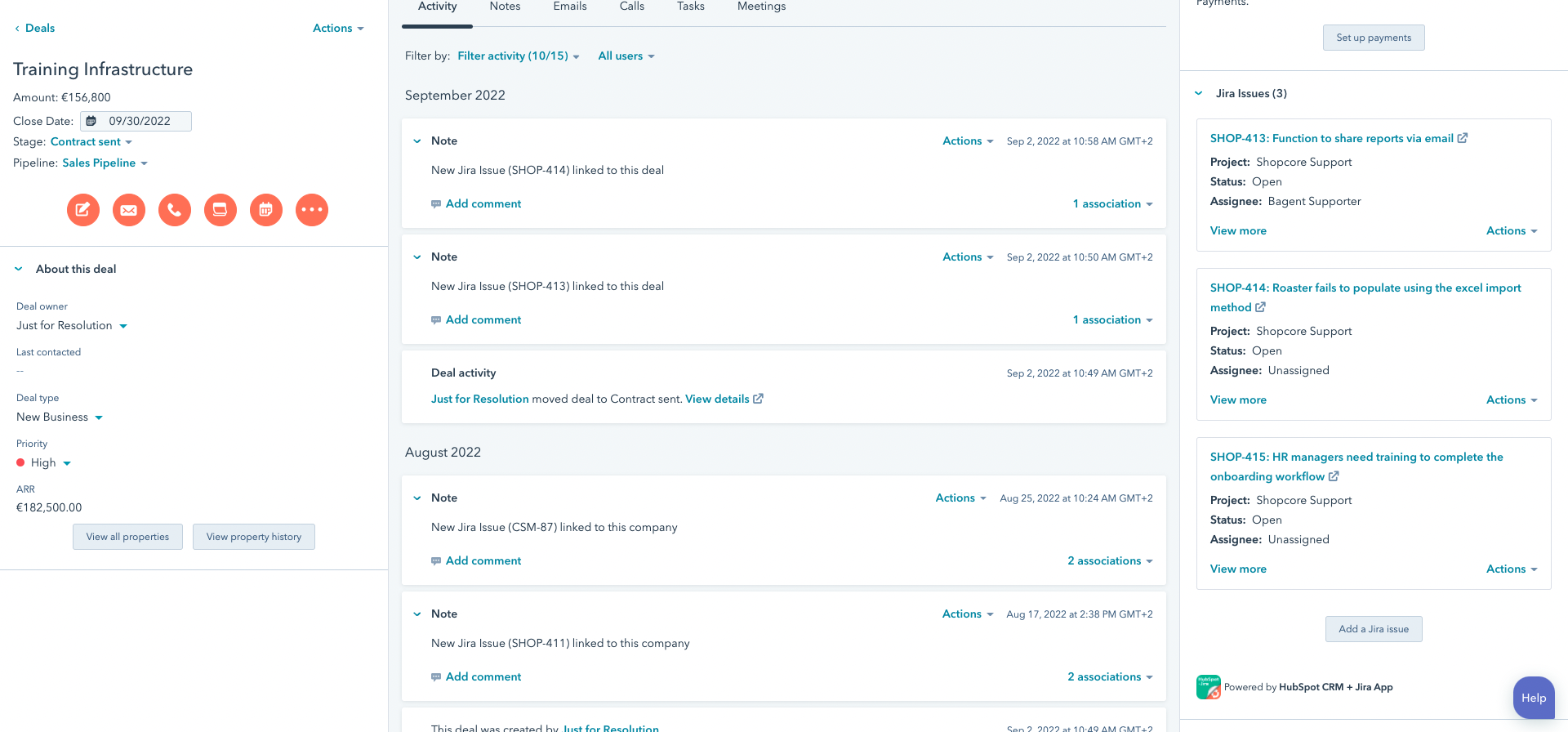
Conclusion
A culture of collaboration between sales executives and engineers won’t happen in a day. We have seen that there are many factors at play.
Sales executives must learn how to share customer demands constructively. Engineers must learn to listen and respond creatively to the requests. Information must flow back and forth. And the right technologies must be adopted so that communication isn’t lost.
Adopting a tailored integration like HubSpot CRM for Jira can prove instrumental in making this shift towards revenue operations at the product level. Instead of chasing customers to pay for a product that is being built for the sake of technology, market needs should be the wind that pushes the product forward.
We look forward to your feedback on how the integration has helped you make Jira more useful to customer-facing profiles, and HubSpot more amenable for technologists.

